MXA MOTOCROSS RACE TEST: 2018 HONDA CRF250
Q: FIRST AND FOREMOST, IS THE 2018 HONDA CRF250 BETTER THAN THE 2017 CRF250?
A: In some ways, yes; in other ways, no. It is hard to understand Honda’s logic sometimes. Throughout Honda’s motocross history, it has conquered, been defeated, rebuilt and conquered again. Its highs and lows have been a roller-coster ride—all smiles going up and all screams going down. It was once a “ride red world” out there, but ever since the ill-fated 2009 CRF450, the orange, white, green and blue bikes have siphoned the majority of red riders away to a different color. There have been Honda loyalists who have refused to switch, just as there have been hardcore yellow holdouts waiting for their new weapon to be released. Honda’s string of less-than-stellar machines (2009–2016) cost the company at least 50 percent of its regular customers. But, for Honda, redemption started with the 2017 CRF450 and continues in 2018 with the all-new CRF250 (Suzuki’s minions may have to wait a little longer for a new RM-Z250).
The 2018 Honda CRF250 has the same chassis as its big brother. The engine has been completely redesigned. Its power personality has been completely made over. It features electric start, coil-spring forks, a Ti gas tank and a DOHC valve train—all good. But, it packed on the pounds and traded usable power for nether-region revs. Plus, it features an electric start that porked up the weight. The 2018 CRF250 has its charms, but Honda also made obvious compromises in the development process.

Q: WHAT DID HONDA CHANGE ON THE CRF250 FROM 2017 TO 2018?
A: The CRF250 of yesterday has nothing in common with the CRF250 of 2018. This bike is completely new from the ground up; however, Honda’s engineers didn’t throw the baby out with the bath water. Honda kept many of the great attributes that make a Honda a Honda. Where Honda really changed its thinking was in regards to the powerplant. Its head engineers never seemed to care about peak horsepower in years past. They focused more on an easy-to-ride style of power. In a class where horsepower is king, Honda’s “slow is better” way of thinking slashed sales of the 2017 CRF250 by 27 percent. Honda knew that something needed to change, and so the soul searching began. The “slow is better” mantra had to go. Here is what Honda came up with:
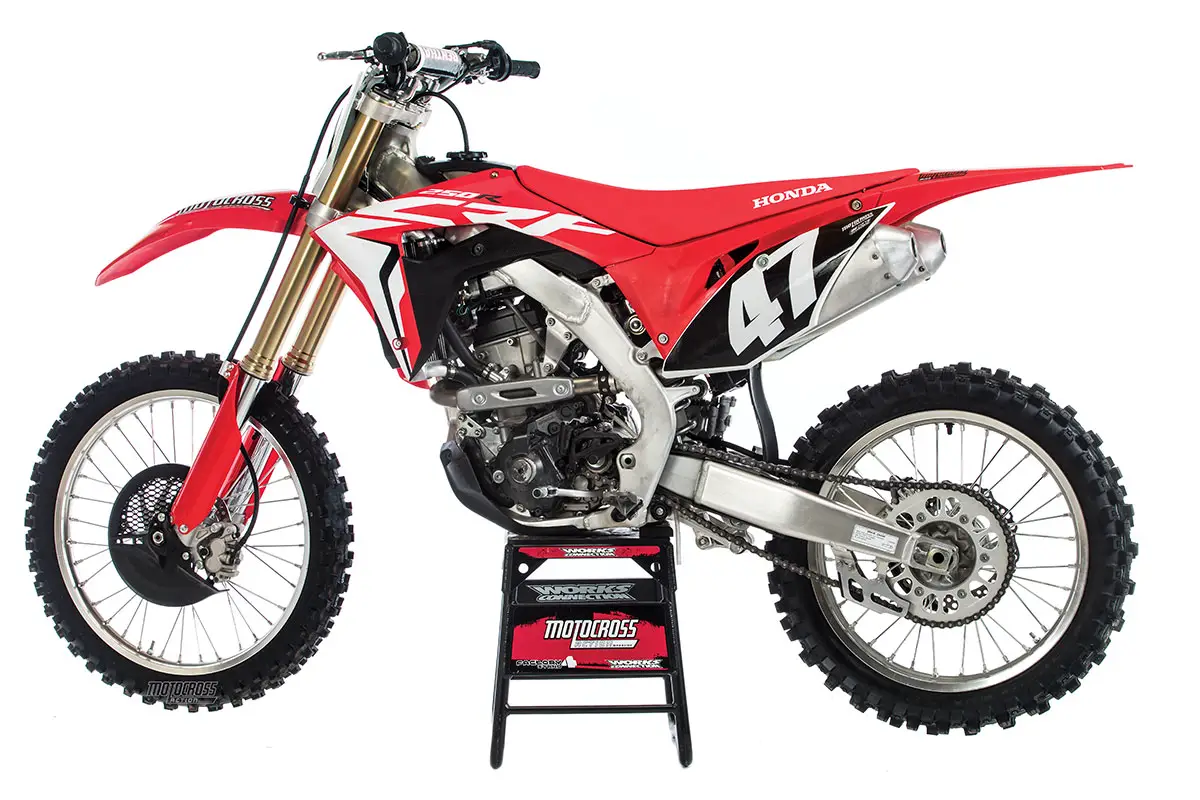
2018 CRF250 ENGINE FACTS
(1) Cams. For 2018, Honda drop-kicked the Unicam engine design that it has had since the inception of the CRF250 back in 2004. Honda went with a double overhead camshaft (DOHC) with finger-follower rockers in search of a high-rpm power curve. The intake valve lift has been increased from 9.2mm to 10.5mm. The exhaust valve lift has been increased from 8.4mm to 9.5mm.
(2) Cam chain. The cam chain has been moved from the left to the right side of the engine. This switch allows the new electric starter to be placed in a more compact and central location on the engine.
(3) Valves. Both the titanium intake and exhaust valves have been increased in diameter (intake from 30.5mm to 33mm, exhaust from 25mm to 26mm), while the valve angle has been changed from 21.5 to 20.5 degrees.
(4) Bore and stroke. Another change made to obtain a higher-revving engine was a bigger bore and shorter stroke. The bore went from 76.8mm to 79mm and the stroke from 53.8 to 50.9mm. The cylinder offset has also been changed from 4mm to 4.5mm, and a bridge-box piston is now used.
(5) Crankshaft. The new H-shaped cross-section crankshaft is 350 grams lighter (about 3/4 of a pound). The compression ratio has also been changed from 13:5:1 to 13:9:1.
(6) Lubrication system. Instead of having two separate oil systems, there is now only one. This simplified lubrication system works smoothly with 300cc less oil. The oil jet piston is new and now has a four-piston oil jet instead of two.
(7) Clutch. The clutch basket has a modified shape, and the friction plates are made with two materials instead of one.
(8) Gear ratios. The gear ratios are vastly different from the 2017 model’s but are similar to the 2018 CRF450’s (by coincidence). Final-drive gearing is 13/48.
(9) Electric start. This is the first year of electric start on the CRF250. It has the same Eliiy HY85S LiFePO4 (lithium-iron phosphate) battery as the CRF450.
(10) Intake system. The downdraft layout of the intake system is identical to that of the 2017-’18 CRF450.
(11) Exhaust. There are now two exhausts ports, which means twice the spigots, twice the flanges and twice the head pipes (although the number of mufflers stays the same).
CHASSIS FACTS
(1) Geometry. The geometry is essentially identical to the 2017–’18 CRF450’s. Compared to the 2015–2017 CRF250, the 2018 CRF250 has a shorter wheelbase (3mm less), shorter swingarm (15mm less), slacker rake (0.1 degrees) and reduced trail (2mm).
(2) Frame. The frame is very similar to the 2017–’18 CRF450’s Delta Box design. Only the engine cradles are obviously different. The frame has tapered main spars and is 340 grams lighter.
(3) Subframe. To save weight, the rear of the subframe is manufactured using an extruding process instead of forging.
(4) Tank. The gas tank is now made from titanium instead of plastic, lowering the weight by 513 grams.
(5) Forks. Honda switched from the Showa SFF-Air TAC fork to Showa’s 49mm A-kit style coil-spring design.
(6) Shock. The shock has been lowered 39mm to make room for the downdraft intake system that runs above it.
(7) Swingarm. The swingarm is 15mm shorter and 220 grams lighter.
(8) Styling. The bodywork is all new for 2018 (resembling the 2018 CRF450 plastic).
(9) Tires. Last year’s old-school Dunlop MX52s have been replaced with Dunlop MX3S tires (front and rear).
Q: HOW DOES THE 2018 CRF250 ENGINE PERFORM ON THE DYNO?
A: The 2018 CRF250 produces 40.70 peak horsepower, which is 1.81 ponies more than the 2017 model. Not a bad increase at peak, but don’t get too excited. The 2018 CRF250 loses 4.39 horsepower at 8000 rpm and 0.77 pound-feet of torque to the 2017 CRF250. Make no mistake about it, the 2018 model is a high-revving, top-end-only bike. Do you know what other bikes fit that description? The KTM 250SXF and Husqvarna FC250; however, the FC250 makes 3.53 horsepower more at peak, 3.71 more at 12,000 rpm and 4.01 more at 8000 rpm. The FC250 even produces the most torque in its class at 20.73 compared to the CRF250’s 19.09.
Q: HOW DOES THE HONDA CRF250 ENGINE PERFORM ON THE TRACK?
A: Let’s talk about the 2017 CRF250 for a minute. That bike didn’t set the world on fire. It had good bottom-to-mid power but signed off quickly on top. Although it was considered slow for a 250F machine, it had its purpose. It was an easy-to-ride bike that was great for riders moving up from a minicycle or for an entry-level rider. No MXA test riders hated riding the 2017 CRF250, but everybody hated racing it.
The 2018 CRF250 engine is the complete opposite of its predecessor. This is both good and bad. If it were a perfect world, we would take the bottom and midrange from the 2017 model and combine it with the top-end power of the 2018 model to make one very good powerband. Even in fairytale land, the Husky FC250, KTM 250SXF and YZ250F powerplants would still out-power our imaginary combined-powerband dream machine. Even the KX250F would be biting at its heels.
Getting back to reality, the 2018 CRF250 engine is vastly different to ride than any other 250 four-stroke powerplant in its class. To get the most out of this engine, you must keep the momentum moving while living between 10,000 and 12,000 rpm. Paradoxically, to get through a tight corner without falling over, you must downshift—a lot. This brings some other engine oddities into play. First, engine braking in Map 1 is mild. This allows the suspension to stay calm and not load up so it doesn’t aggravate the rear end when downshifting into corners. Second, the MXA test riders liked the power gains from bottom to mid with the more aggressive Map 3, but engine braking was increased. This negatively affected the handling when having to downshift so many times.
The 2018 CRF250 engine will allow you to hold it wide open in second gear going up the long start straight at Glen Helen without falling on its face. We like this. If you don’t want to shift, you don’t have to. The power does fall flat, though. The engine starts to get loud after you hit 12,000 rpm. Not a concerning loud, just old-silencer-packing loud. The high-decibel sound makes you feel like you’re moving faster than you actually are. You feel the bike has more to give, but, in reality, the optimal shift point has come and gone. When you do hit that next gear, there’s a 50/50 chance you will hit the CRF250 engine’s sweet spot. To find it, you have to be carrying good speed and not be going uphill. It’s not a very wide sweet spot, and it is almost impossible to hit it two upshifts in a row. This engine thrives on high-speed tracks with minimal elevation changes and struggles on tight tracks, sand and big hills.
Q: IS THERE AN EASY FIX TO GET MORE BOTTOM AND MID OUT OF THE ENGINE?
A: This is not a fix but more of a Band-Aid. The stock 13/48 gearing combo is too tall for a top-end-only bike. Going to a 49-tooth rear makes a huge difference. The shift point’s sweet spot got bigger and easier to find. The power became more playful and usable. Our Vets and Novice riders opted for a 50-tooth rear sprocket. These riders don’t carry speed through corners as well as Pros. Slower riders need a burst of power when exiting corners to get them moving again. Plus, they were forced to downshift any time the engine had a big load on it. The 50-tooth rear suited these riders better, but was too low for MXA’s faster test riders.
Q: WHAT DID WE THINK OF THE UPDATED CHASSIS?
A: The new chassis was awe-inspiring for any rider who jumped on the bike. You can be fat, skinny, tall or small, and the 2018 Honda CRF250 chassis will make you feel right at home. Our only complaint was that the bike oversteered at turn-in with the recommended sag of 105mm. There was an easy fix. We dropped the sag down to 107mm, which gave us more consistency coming into and getting out of corners. Some riders also dropped the forks into the clamps from 5mm to 3mm to get more weight to the rear. It made the bike track better and become more stable at speed.
In the air, the CRF250 feels light and easy to maneuver. When you hit the ground, you can feel the additional weight of the electric start, DOHC engine and twice pipes, but the Showa components soak up the added weight with grace.
The handling and feel of the CRF250 are its saving graces. The Showa A-kit spring forks work superbly under the new chassis. It makes riding easier. You use less energy and ride more effortlessly.
Q: ARE THE SHOWA COIL-SPRING FORKS BETTER THAN THE YZ250F’S KAYABA SSS FORKS?
A: A good chassis makes good suspension that much better. We can’t say for sure which forks are better without putting the 2018 Showa forks on the YZ250F and the Kayaba SSS forks on the CRF250. Both the Kayaba SSS and Showa forks work great for the masses without big swings in adjustment. They both offer good bottoming resistance and hold up well in the stroke with minor adjustments. They both deliver a supple feel at the top of the stroke and gradually ramp up in firmness without any harsh spots.
If we had to pick a winner, it would be the Showa forks on the CRF250—not the Showa forks on the CRF450. Good valving goes a long way, and Honda nailed it. We had more than 10 different test riders race the CRF250. They ranged in skill level from Novice to AMA Pro, in weight from 120 to 220 pounds and in age from 17 to 65. Among all the riders, no one made a clicker adjustment after the initial setting was found, which isn’t far off stock. Pretty impressive.
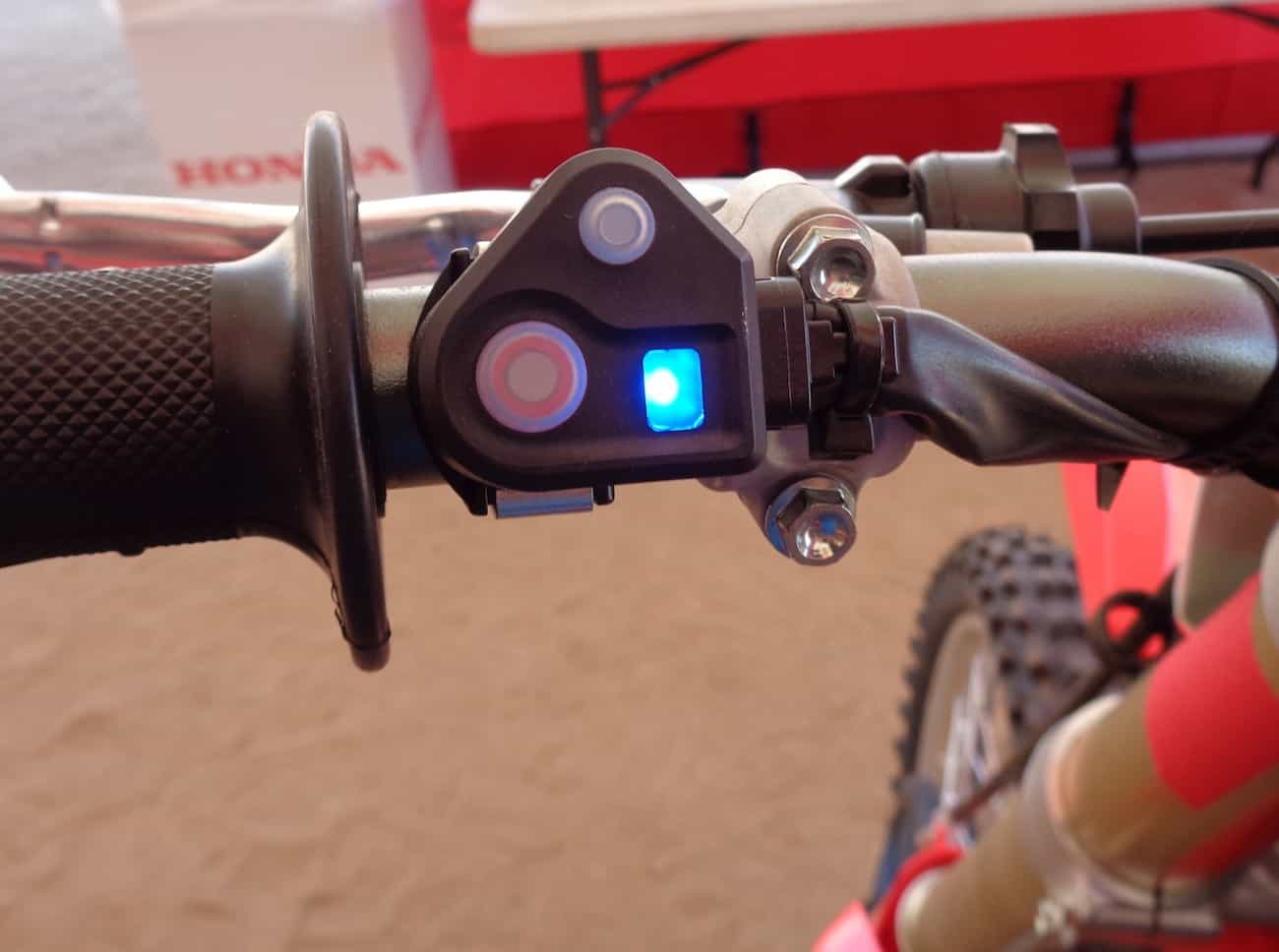 The three maps Honda chose for their EFI mapping are good. One is mellow, one is aggressive and one is smooth.
The three maps Honda chose for their EFI mapping are good. One is mellow, one is aggressive and one is smooth.
Q: WHAT IS THE BEST EFI MAP?
A: There are three different maps to choose from. These maps are chosen from the engine mode select button that is located on the same multi-switch as the kill switch. Map 1 is the standard map (one blue flash), Map 2 is the mellow map (two blue flashes) and Map 3 is the aggressive map (three blue flashes). The standard map was our go-to map. It ran clean and had a freewheeling sensation that freed up the high-revving engine on deceleration. Once we geared the bike lower, everyone ran this map. The mellow map was too soft for every rider who jumped aboard. Although it has its purpose in muddy conditions and on super-slick tracks, it would never be used in normal conditions. Most test riders preferred the aggressive map initially, and a few stuck with it because it brought some of the power lower and had a more responsive feel at the throttle. The biggest complaint about Map 3 was the increase in engine braking. Excessive engine braking increases the loading up of the rear suspension, making the bike both harsher in the braking bumps and less accurate at turn-in. Map 3 is, however, is a map that can be customized with the HRC tuning tool ($495.95) or the GET WiFi-Com ($204.91). Overall, we liked that there were three usable maps that worked well for a variety of different conditions. It should be noted that the 2018 CRF250 does not have launch control or traction control.

Q: HOW MUCH DOES THE BIKE WEIGH?
A: Honda was able to lose weight in the engine and frame for 2018, but then gained weight everywhere else. The math does not balance the books. The weight lost doesn’t come close to the weight gained on the 2018 CRF250. Last year’s 2017 CRF250 weighed 224 pounds, which put it next to last in its class. With Honda going from air to spring forks, adding an additional exhaust port/spigot/flange/ head pipe, adding an electric starter, and using the double-overhead-cam layout, the 2018 CRF250 comes in at a whopping 228 pounds. That’s 6 pounds heavier than the KTM 450SXF and 10 pounds more than the 2018 KTM 250SXF. Honda has a lot of work to do, but it can be done because the KTM 250SXF weighed 231 pounds in 2014. The Austrians whittled 13 pounds off their porker 250 in four years.
Q: WHAT DID WE HATE?
A: The hate list:
(1) Engine. We are tickled pink that the new engine has been hitting the gym, but it skipped leg day. A 250F engine needs more than just top-end power to be competitive and user-friendly. It feels like a highly strung CR125 two-stroke engine in motion. Plus, we are nervous about why there is 2000 rpm band (12,000 to 14,000 rpm) that seems to be a continuous soft rev limiter. We have to wonder why Honda decided not to let the 2018 CRF250 rev to it mex—perhaps reliability. The narrow powerband makes the CRF250 a one-trick-pony engine.
(2) Weight. This bike needs its own weight class. There is no nice way to say “tub of lard.”
(3) Covers. Both the paint on the ignition cover and clutch cover become scratched on the first ride. Honda should switch to brushed aluminum.
(4) Cooling. Our 2018 CRF250 used water every time we raced it—at an alarming amount.
Q: WHAT DID WE LIKE?
A: The like list:
(1) Handling. This bike handles intuitively.
(2) Forks. The Showa A-kit forks work great for a wide range of riders. They do many things right and nothing wrong.
(3) Tires. We love the Dunlop MX3S front and rear tires that come standard.
(4) Maps. The three different maps are all distinctly different and functional.
(5) Ergos. Everyone loves the feel of this bike.
(6) Clutch. This clutch has a soft, easy clutch pull and can take a beating when compared to last year’s clutch—although it’s not nearly as durable as KTM and Husqvarna hydraulic clutches.
(7) E-start. We love being able to start a bike with the push of a button. Honda just needs to find a lighter way to utilize it.
Q: WHAT DO WE REALLY THINK?
A: We want to love this bike; we really do. It does many things well and some things great. But, there are two things that spoil the 2018 Honda CRF250 for us—the powerband and the weight. Maybe a CRF450 rider can live with added tonnage, because a 450 has an excess of power to haul the baggage around. But, the CRF250 doesn’t have any horsepower to give up. It is already almost four horses short of the amazingly light KTM and Husky. Finally, we cannot live with an engine that does not have a usable powerband. The CRF250 engine is so one-dimensional that it gives up all the good stuff for a top end that isn’t good enough. No matter how you slice it, the 2018 CRF250 needs more meat in the middle of the powerband to make its top-end power efficient from gear to gear. Without it, the blue, green, white and orange engines have a big advantage out of every corner.
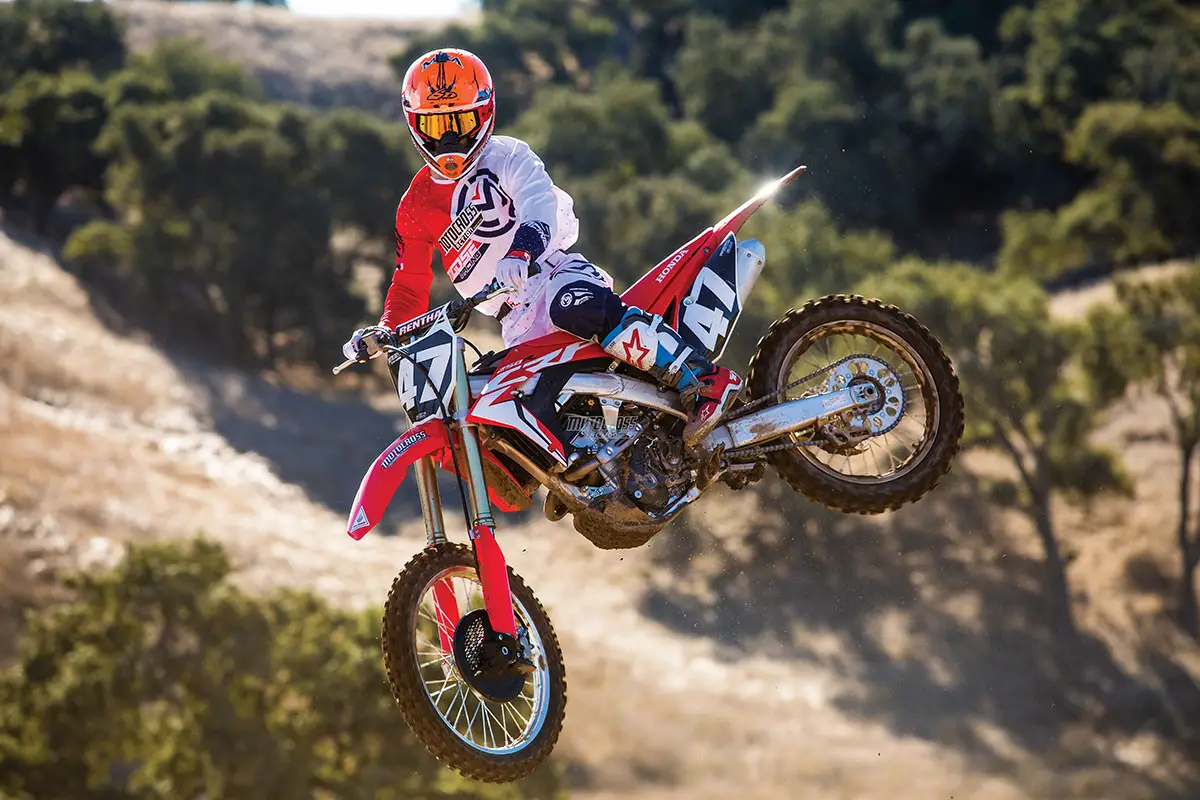 This bike is superb at turn-in. The chassis is effortless to get into corners. Every rider loved the handling of this bike.
This bike is superb at turn-in. The chassis is effortless to get into corners. Every rider loved the handling of this bike.
MXA’S 2018 HONDA CRF250 SETUP SPECS
This is how we set up our 2018 Honda CRF250 for racing. We offer it as a guide to help you find your own sweet spot.
SHOWA A-KIT SPRING FORKS
Honda hit the nail on the head with the valving and spring rates on the Showa coil-spring forks. The initial settings were almost spot-on, although the forks rode down in the stroke a bit. We added a few clicks of compression to hold them a tad higher. Some of the riders also dropped the forks in the clamps 2mm to lessen oversteer. If you are experiencing oversteer, the Mr. Fix-It steps are to first drop the sag and then drop the forks. For hardcore racing, these are MXA’s recommended 2018 CRF250 fork settings (stock settings are in parentheses):
Spring rate: 4.6 N/m
Compression: 7 clicks out (9 clicks out)
Rebound: 13 clicks out (14 clicks out)
Fork-leg height: 3mm (5mm)
Notes: The forks worked well for 140- to 210-pound riders. Ride with these forks before you send them to your suspension guru. You might just be surprised how well these forks work for your weight and skill level. They are much better than the comparable forks on the 2018 CRF450.
SHOWA SHOCK SETTINGS
We set the race sag at 107mm to lower the overall bike height and stiffened up the low- and high-speed compression a few clicks to make it ride higher in its stroke. For hardcore racing, these are MXA’s recommended 2018 CRF250 shock settings (stock settings are in parentheses):
Spring rate: 52 N/m
Race sag: 107mm (105mm)
Hi-compression: 3-1/4 turns out (3-1/2 turns out)
Lo-compression: 9 clicks out (11 clicks out)
Rebound: 7 clicks out (8 clicks out)
Notes: The shock is consistent. It doesn’t do anything out of the ordinary. Lighter riders under 140 pounds will want to stick with the stock settings.
HOW YOU SUBSCRIBED YOU WOULD HAVE SEEN THIS BIKE TEST A MONTH AGO
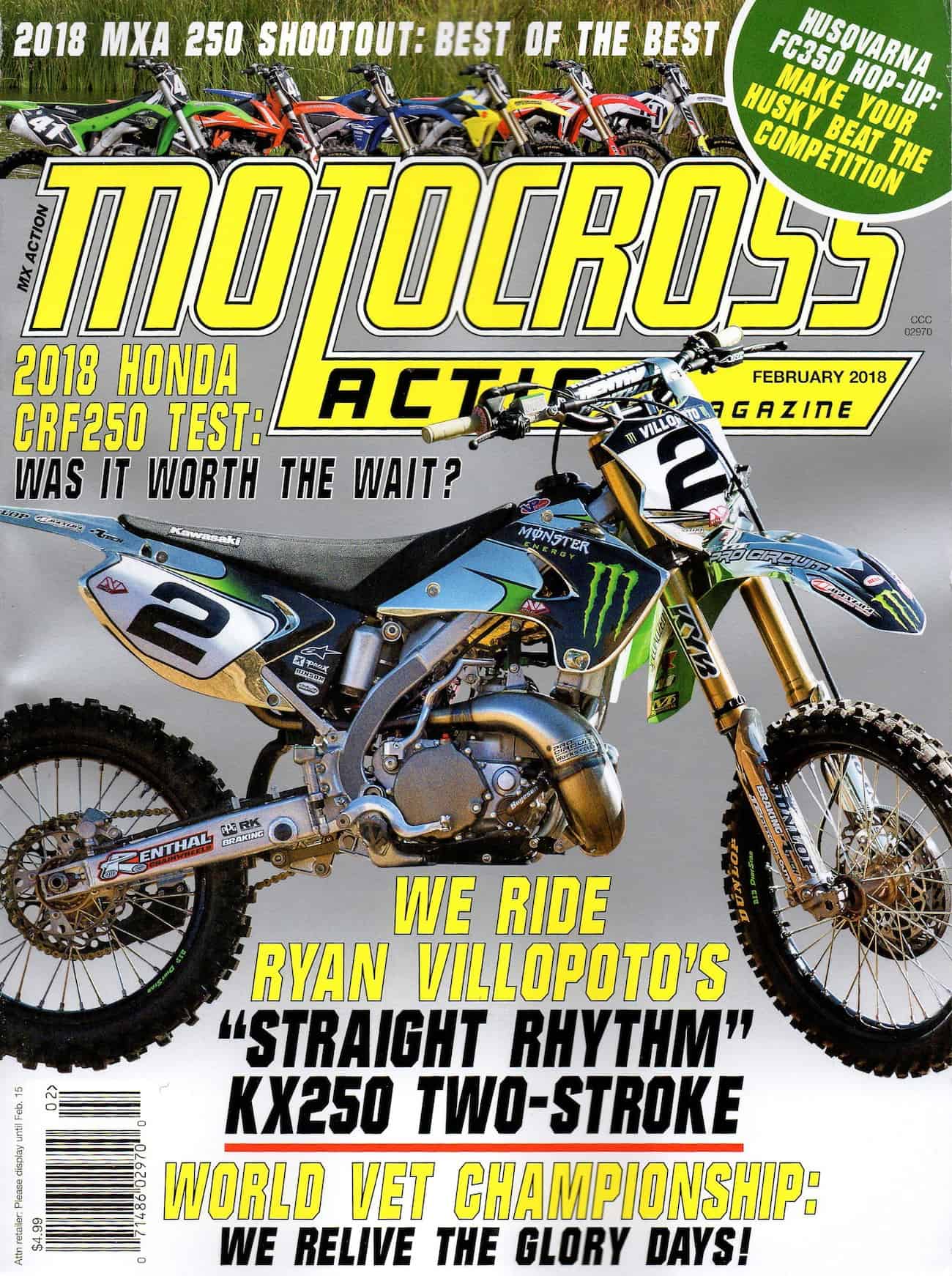 Had you subscribed to MXA, you would have read this complete bike test when in came out back in January. Click the box below to subscribe.
Had you subscribed to MXA, you would have read this complete bike test when in came out back in January. Click the box below to subscribe.


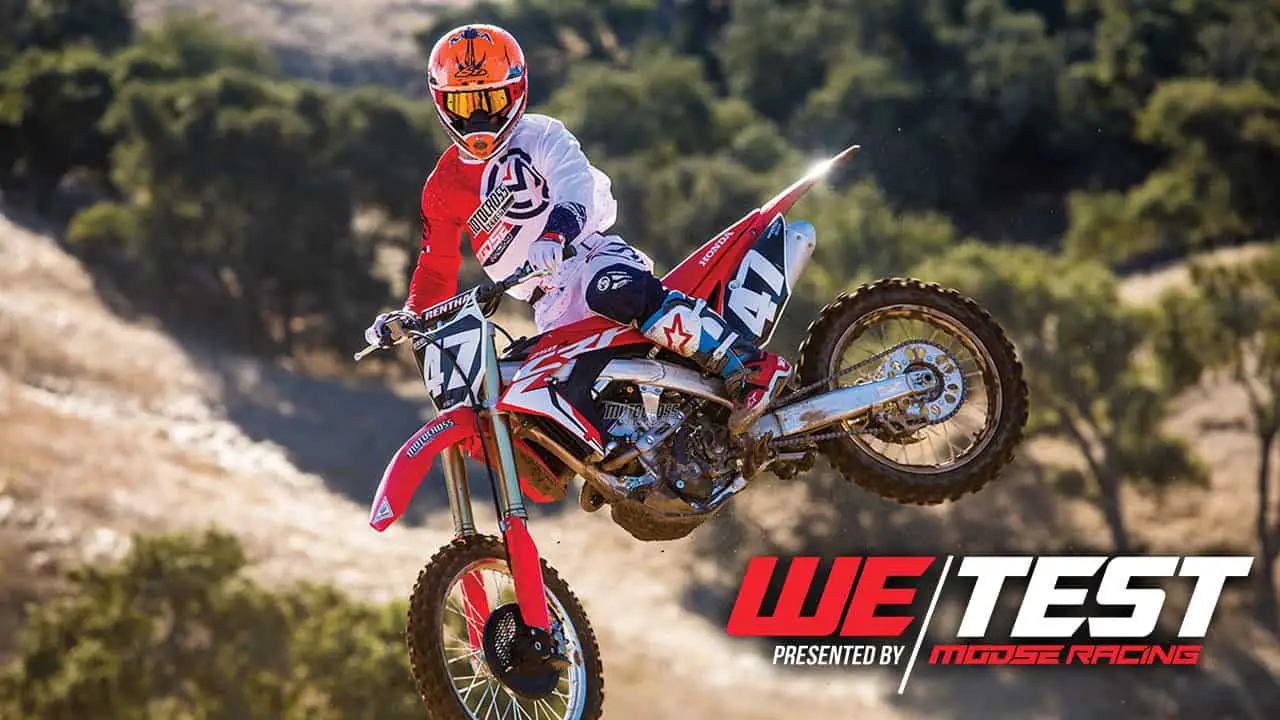
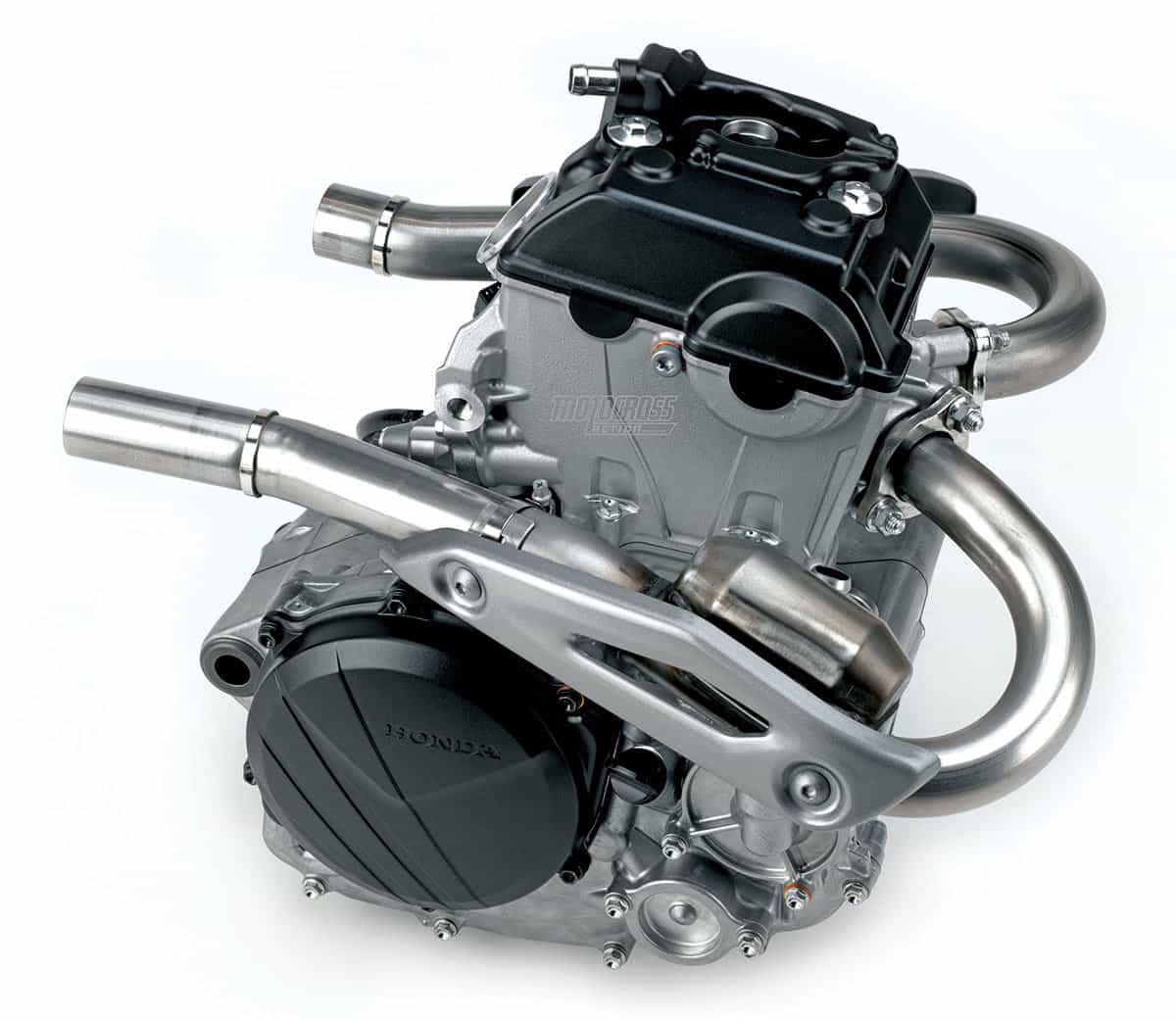
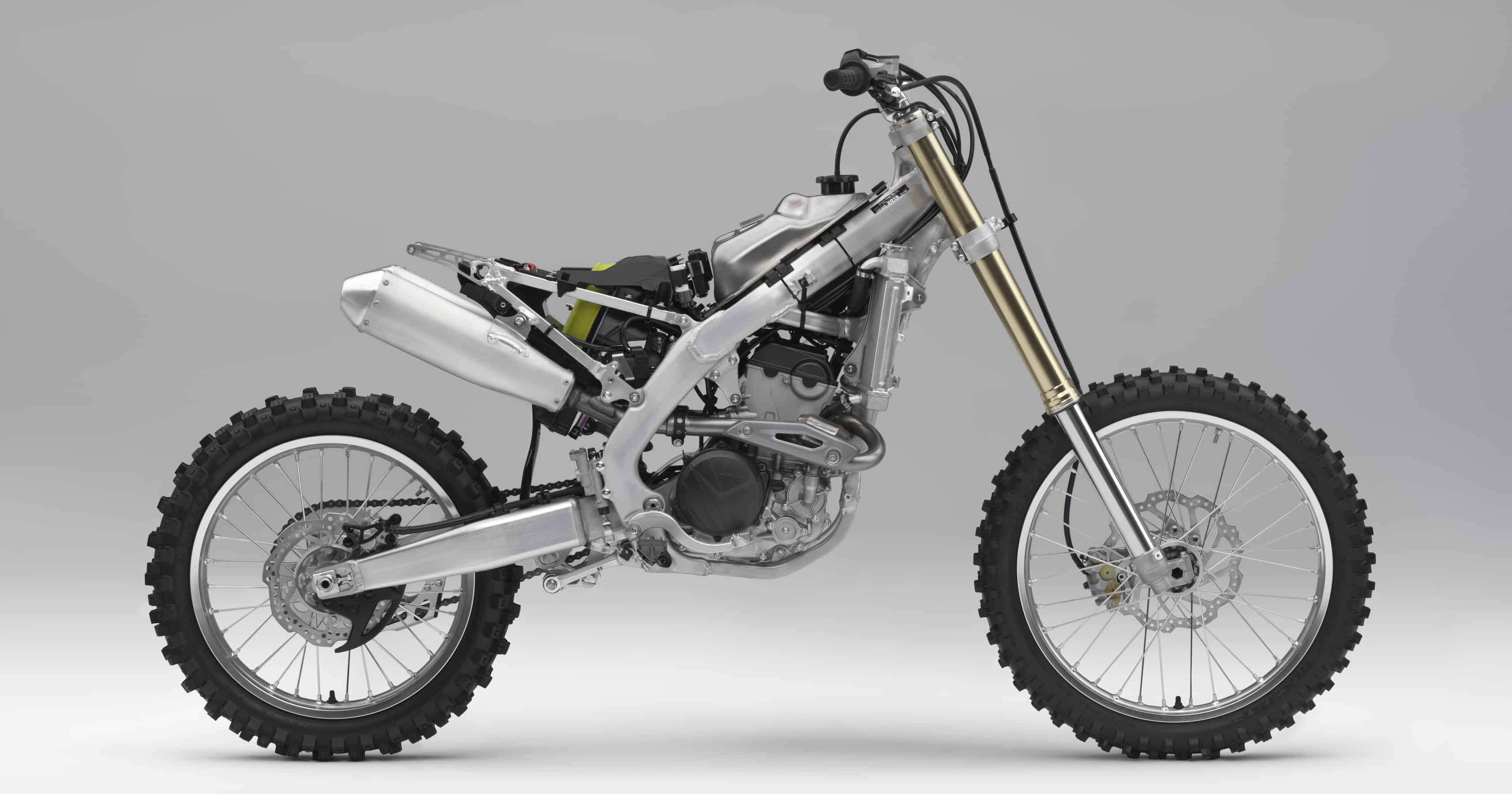
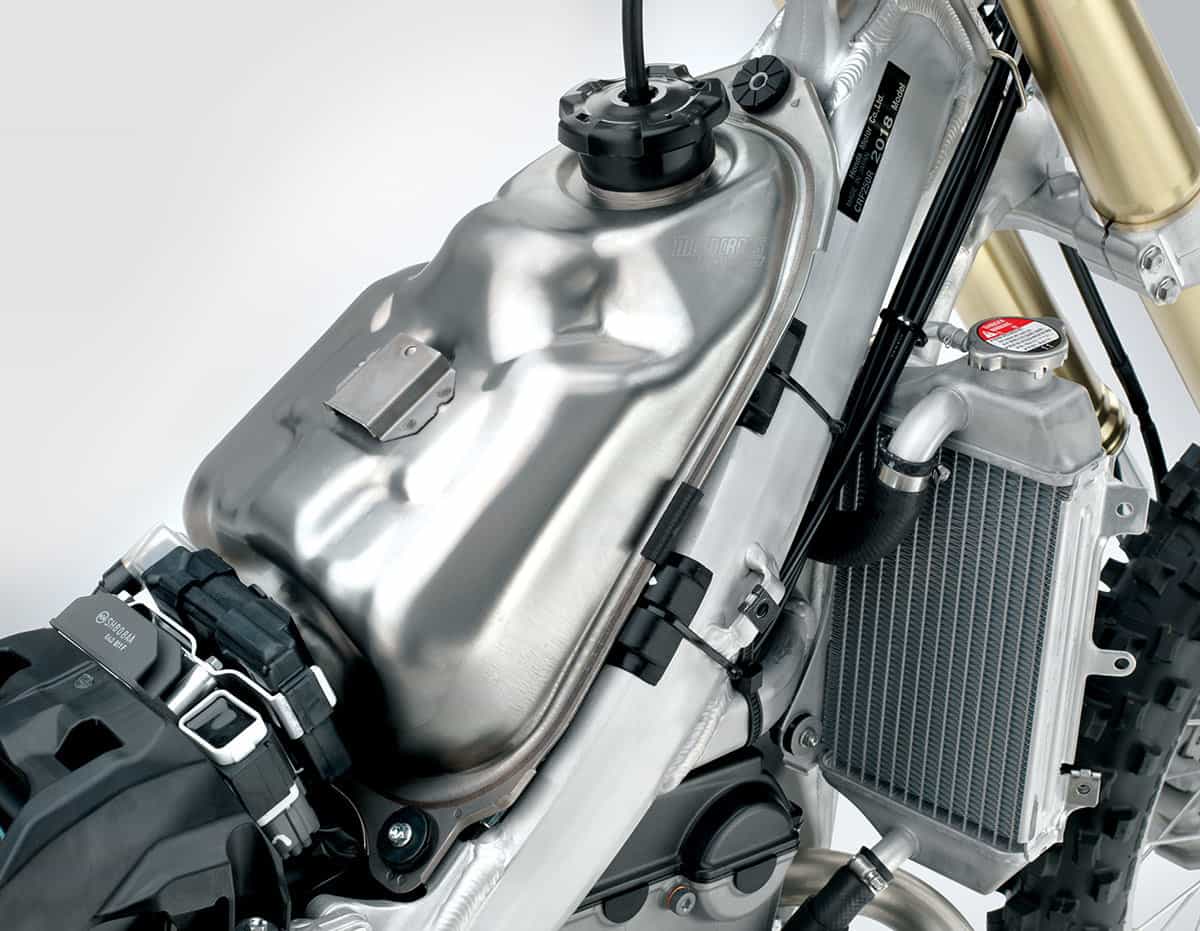
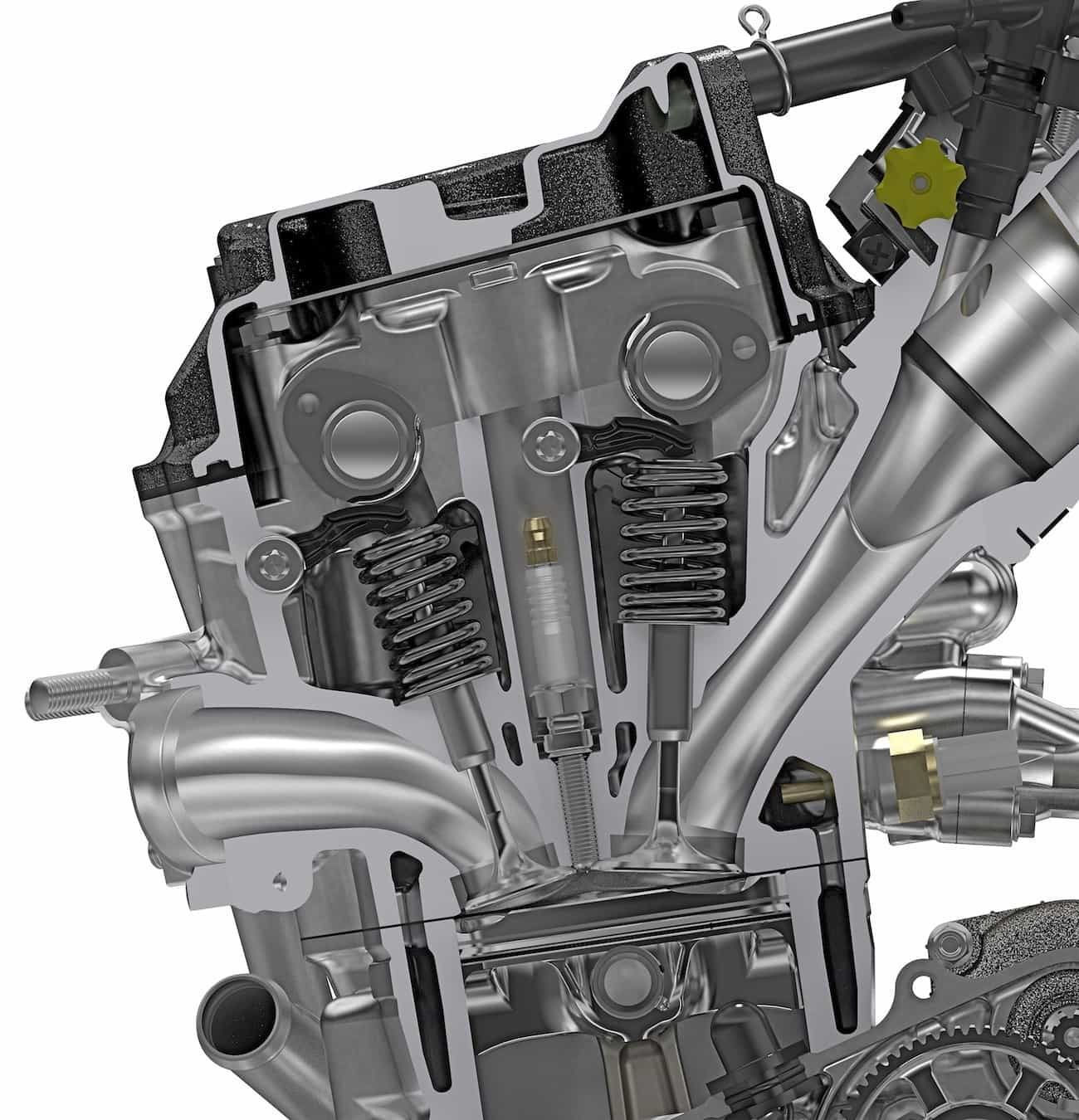
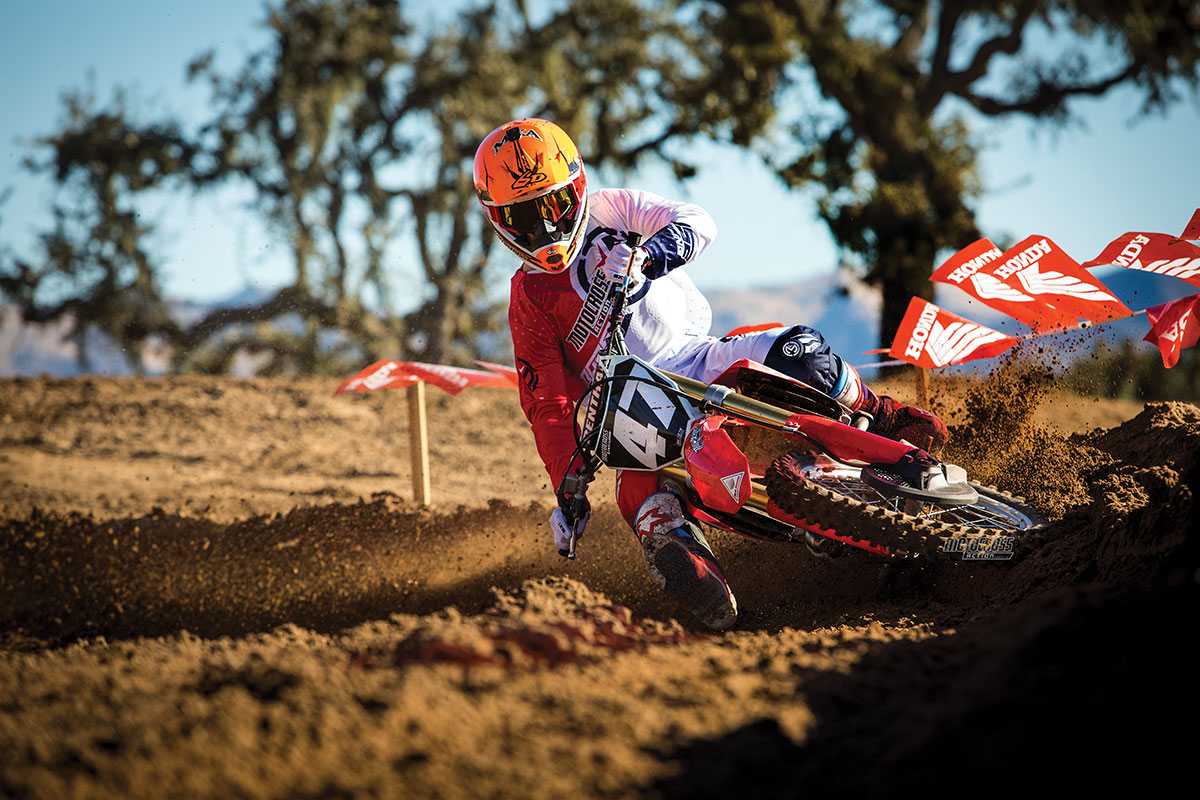

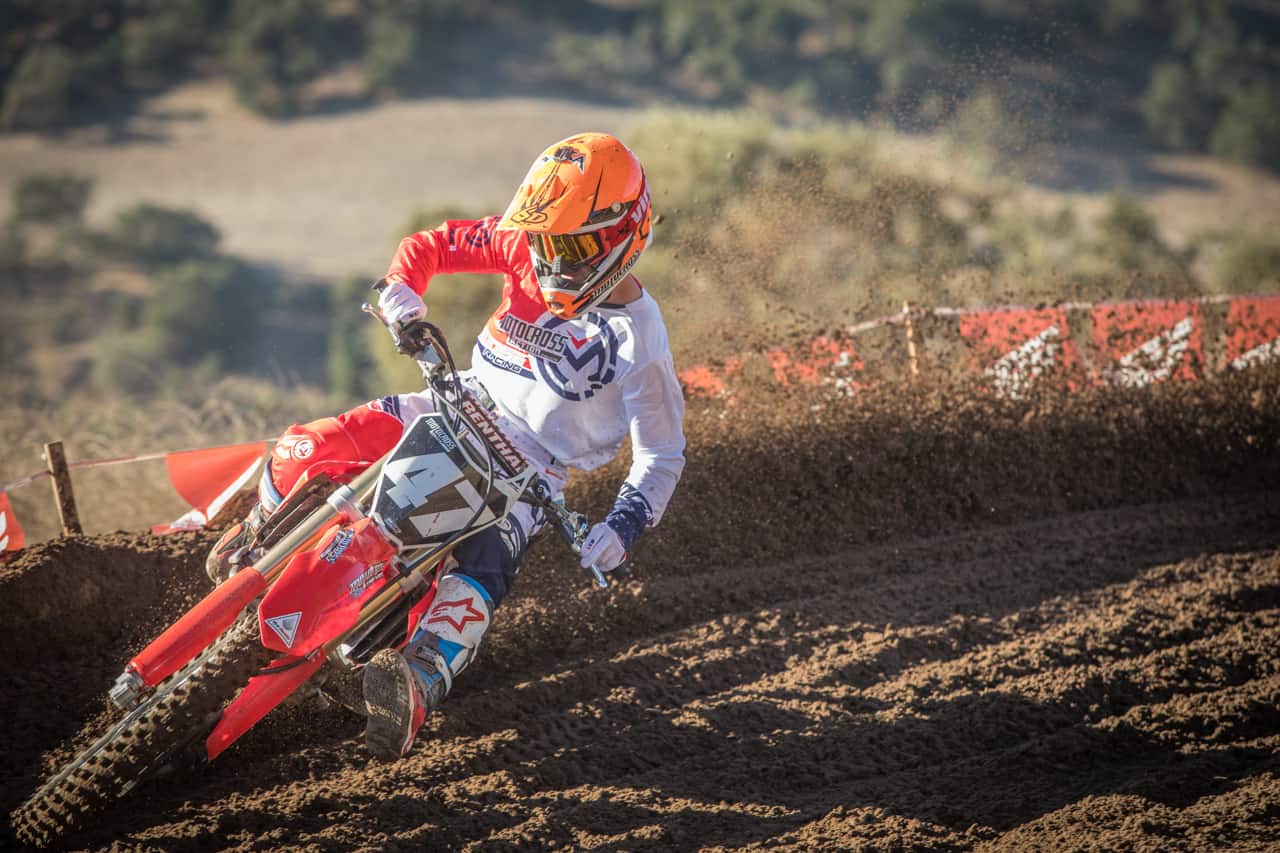
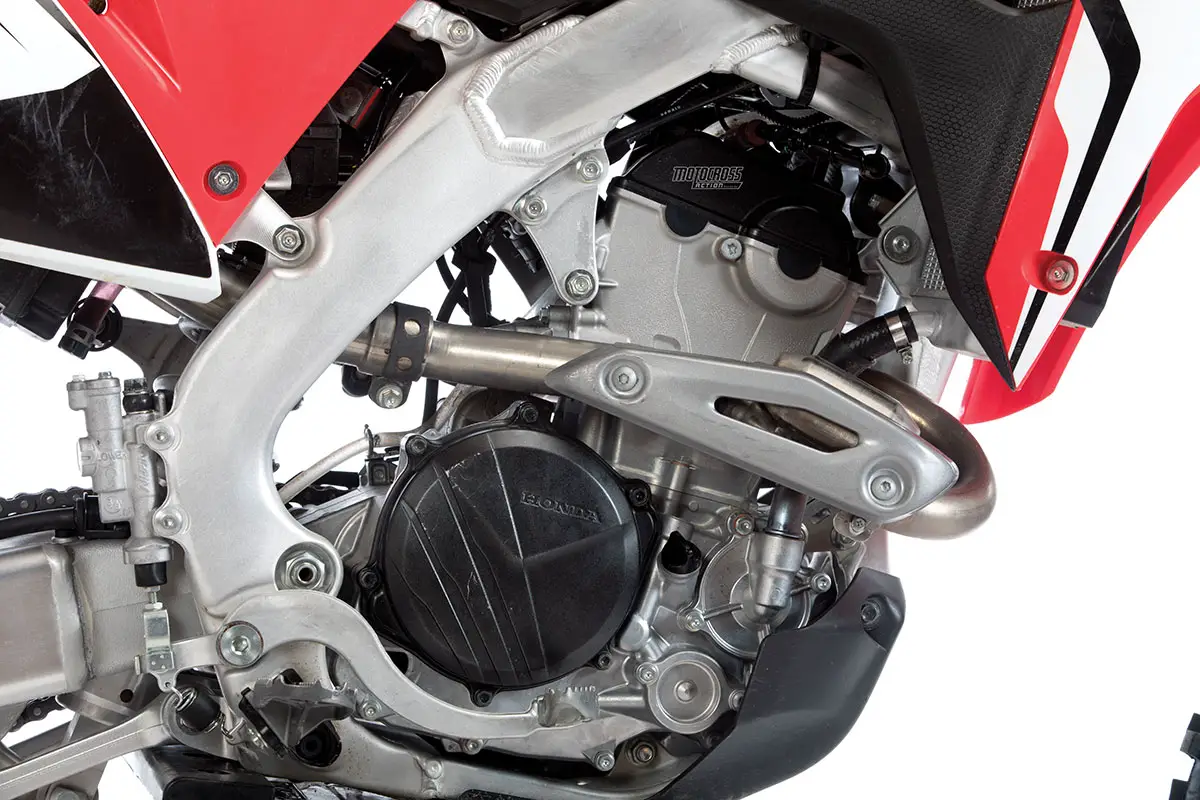
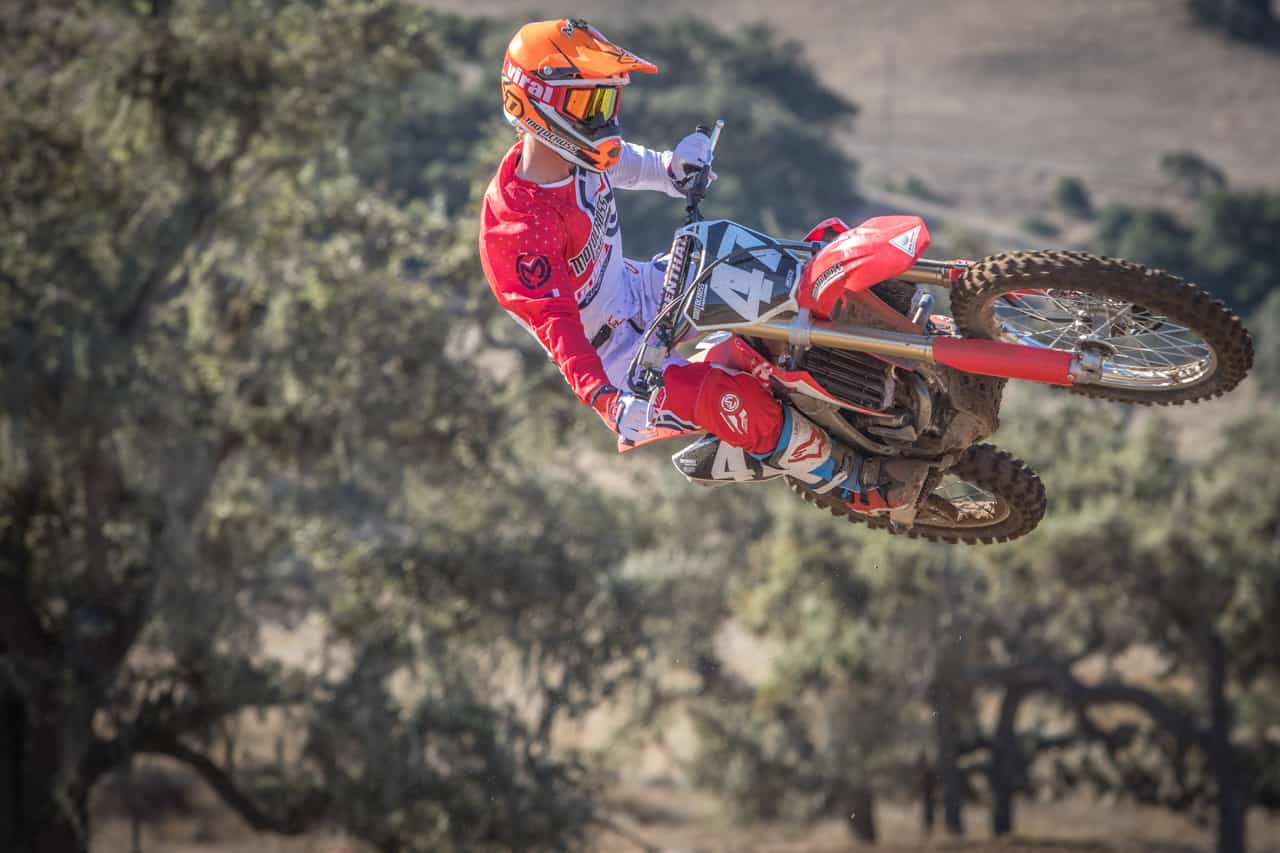
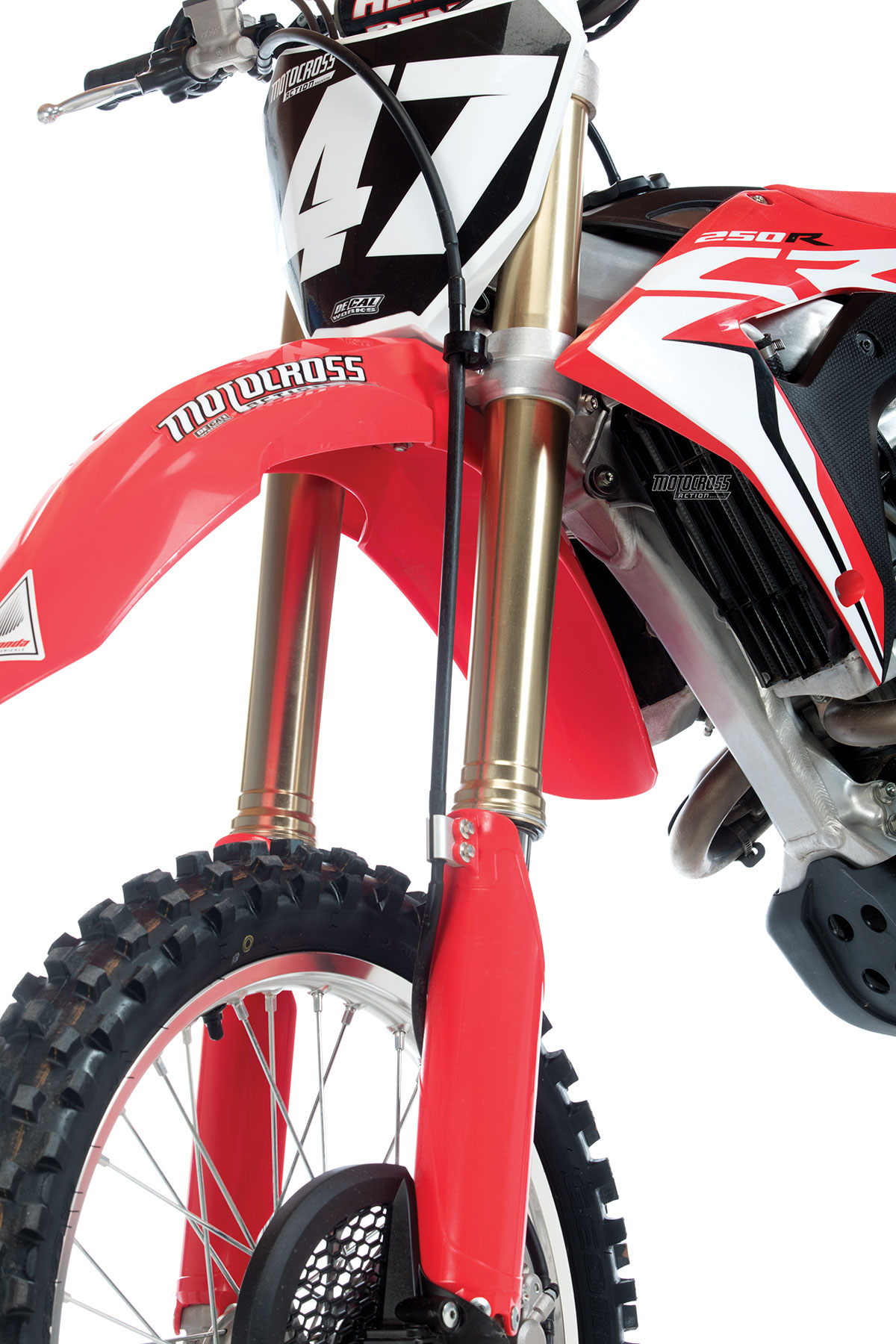
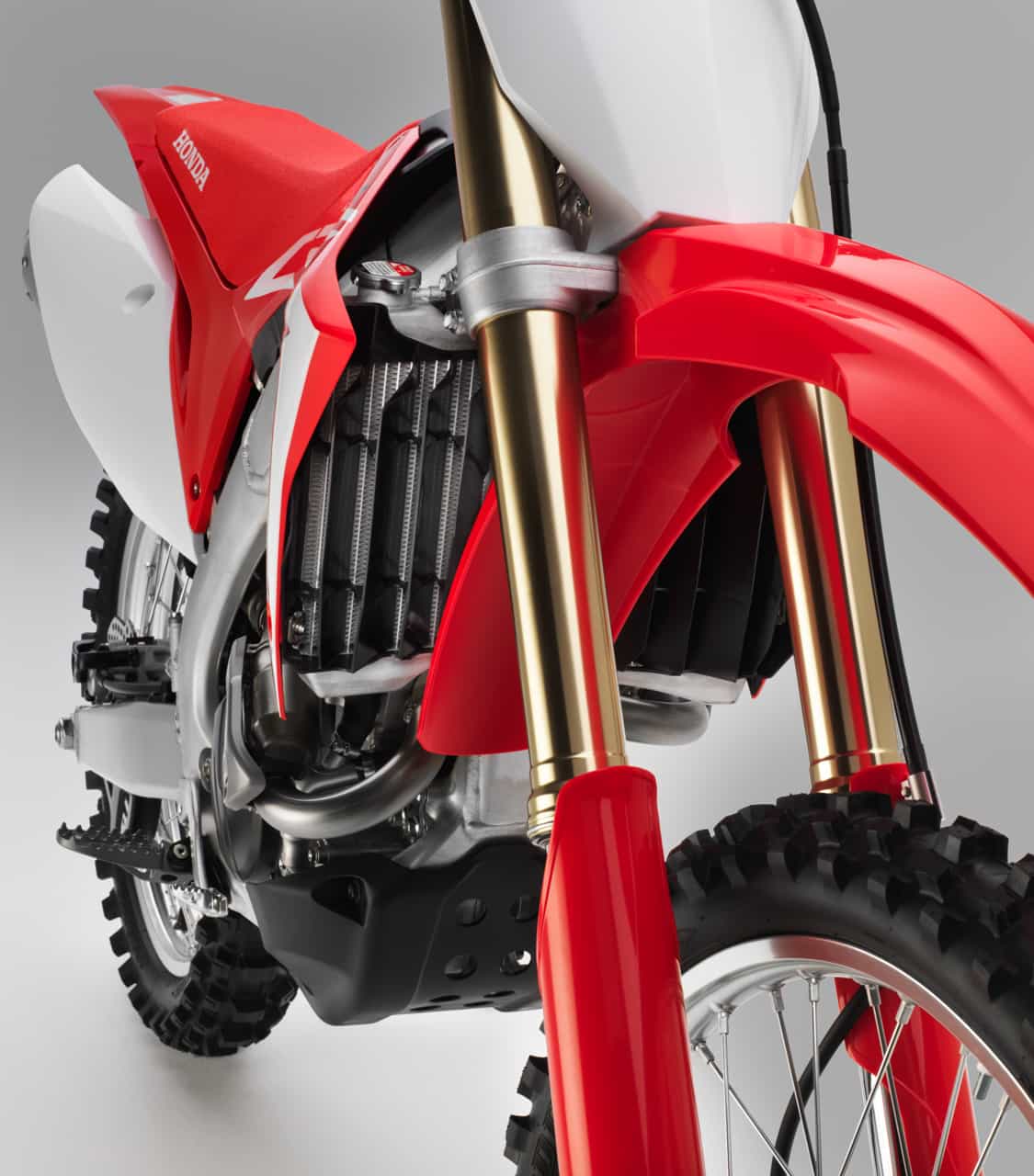
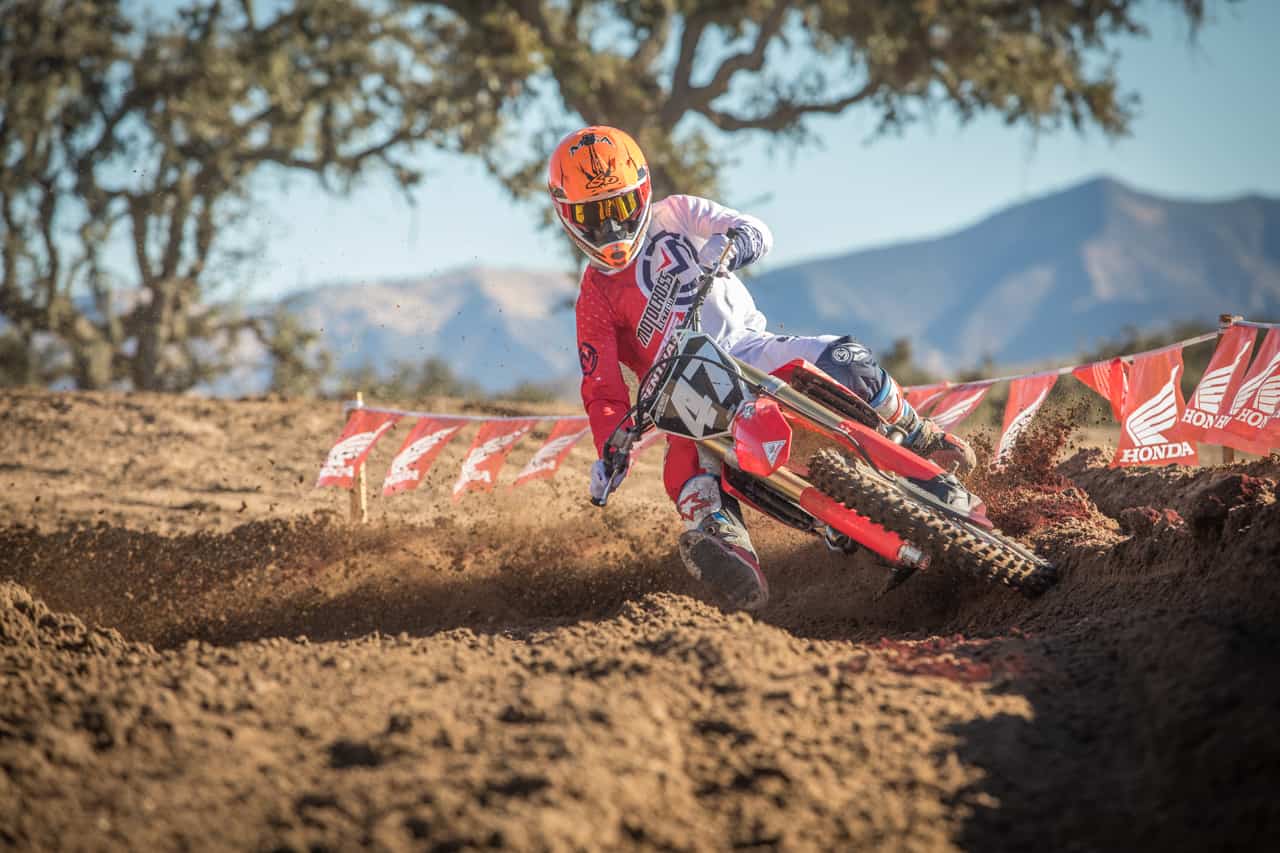



Comments are closed.